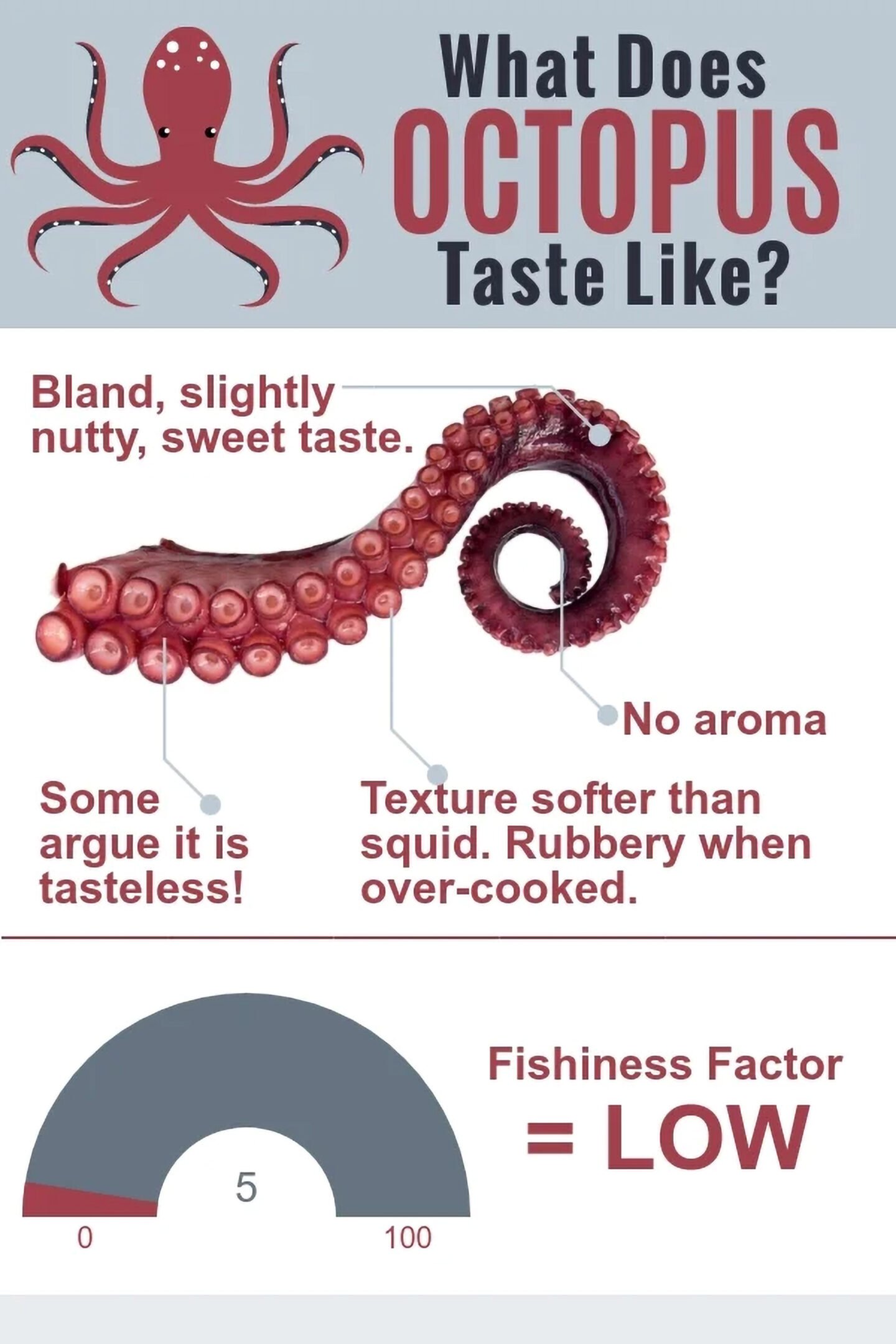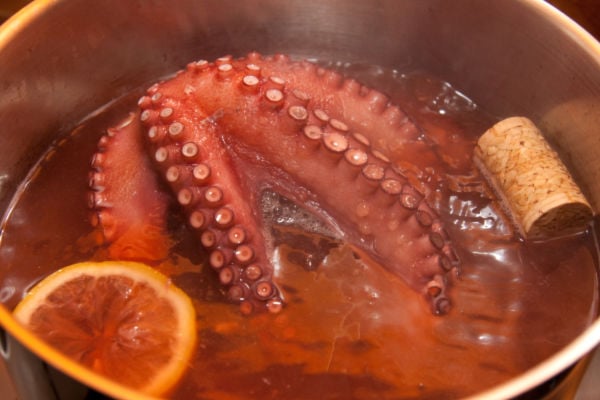If you’re looking to try octopus for the first time, you may be wondering what does octopus taste like? We’ll answer this question next and then follow up with how to cook this sea creature, in case you’re considering serving it at home.

Before we start, let’s get two myths out of the way.
- The octopus has tentacles. Wrong, they’re called arms.
- The plural of octopus is octopi. Nope, the correct term is octopuses.
Okay, now that I’ve got that off my chest, it’s time to take a close look at the octopus.
Table of Contents
What does octopus taste like?
Octopus has a bland taste and a very low “fishiness factor” compared to other seafood. It has virtually no aroma and a soft, crayfish-like texture when cooked correctly. If it is slightly overcooked, the texture transforms into a chewy, rubbery texture.
Octopus is often compared to squid, but the two are different. The texture of octopus is tenderer than squid, and its flavor is more subtle; it has a slightly nutty and sweet taste.

Octopus ink has a unique, rich flavor with an underlying hint of the sea. It is best combined with other ingredients to add umami and a well-rounded briny flavor. The true benefit of using octopus ink comes from its appearance on the plate. Chefs love this ingredient for coloring pasta and sauces and for adding a garnish to the plate.
What’s to like about octopus?
- Its bland taste allows the seafood to absorb whatever flavors you toss its way. It’s a blank canvas, ready for your next masterpiece.
- You’ve probably heard it said before: We eat with our eyes. Octopus looks impressive on the plate; visually, it’s a lot more intriguing than a chicken fillet or pork chop.
- Octopus is a protein that requires very little cooking time. If you’re short on time, then octopus is an excellent option.
Related reading:
A comparison of ssamjang and gochujang - two Korean sauces perfect for dipping octopus into.
What does uni taste like? AKA sea urchin.
The challenges of this seafood
Cooking octopus correctly isn’t easy. If you leave steak or chicken on the heat for a little too long, it isn’t a big issue, but octopus offers no room for error. A few seconds too long, and the texture quickly turns to rubber. Are you looking to cook this protein in your next dish? Use a timer so that you don’t overcook it.
Preparation
If you buy octopus from the store frozen, then you’ll find there is minimal preparation required. Allow it to thaw overnight in the fridge. When it comes to cooking, your only decision will be whether to cook it whole or slice it into pieces. If your octopus is small, then cooking it whole is a good option; however, a larger octopus is best sliced up to ensure even cooking.

If you have caught octopus or bought some fresh from a local market, then you’ll need to remove the internal organs. It’s best to do this in the sink, as it can get a little messy.
My preferred method is to slice off the head, then flip it upside down and look for the inedible beak, which is located centrally between the arms. It’s easy to spot and looks a lot like the beak of a bird. Cut around the beak with a sharp knife and push it out with your thumb.
To remove the "insides,” turn the octopus bag inside out and scrape out the white insides with a paring knife or your fingers.
Can you eat the head of an octopus?
The thought of eating an octopus head is a scary thought for some. In fact, the head is perfectly edible and tastes similar to the rest of the body (it is thinner than the arms, so there is a little less taste). If you’re dealing with a large octopus over 2 pounds, then slice the head before cooking. Otherwise, parts of it will become rubbery before the rest has had time to cook.
Buying fresh vs frozen
We are constantly told on cooking shows that fresh is best, but this isn’t always the case. A frozen octopus, due to the freeze/thaw process, will usually provide a more tender meat than buying it fresh.
Tip: Buy more octopus than you think you’ll eat. Three pounds of octo-meat may sound like a lot, but it reduces down to enough for roughly four appetizers or small mains.
Cooking advice
Octopus is a versatile ingredient that can be cooked using a range of methods: raw, sushi, steamed, seared, grilled, or fried. If you decide to cook a large octopus, then add it to a shallow pan and simmer with no oil, butter, or water added. As soon as it becomes tender, slice it up and briefly fry in an oiled pan.
To cook a small octopus, you can toss the whole specimen into a very hot pan and fry until it's nicely charred on the outside and tender inside.
Tips for cooking octopus
The Greeks beat the meat over a rock to help break up the protein; this produces a similar result to using a meat cleaver.

Italians add a wine cork to the pot when slow-cooking octopus for delectable, tender meat.

The Japanese eat octopus raw by massaging it with salt and bashing it with daikon radish.
Before cooking, dip the arms in hot water so that they curl up. It won’t improve the taste, but they will look elegant on the plate.
Avoid using salt when cooking octopus, as it already has a lot absorbed into its flesh. Salt causes the meat to reduce in volume when cooked, so you won’t want to add any extra.
Popular dishes from around the world
Japanese and Korean cuisine is known for serving up raw octopus that’s so fresh it’s still wriggling on the plate. This snack makes for an “interesting” meal as the suckers are known to occasionally suck on to your insides as they begin the digestion process.
Other common dishes that incorporate octopus include:
Takoyaki

The Japanese commonly use raw octopus, or taco, in sushi.
Muneo-sukhoe
Blanched, sliced octopus served with dipping sauces is popular in Korea.
Arroz de Polvo
A specialty dish originating in Portugal, the octopus is stewed with rice or roasted with vegetables, garlic, and oil.
Chargrilled octopus

The chargrill method is popular all over the globe. It's especially popular in Greece, served in a salad.
Frequently Asked Questions
The suction cups of an octopus are perfectly edible and should not be removed before cooking the arms. They also add an interesting visual appeal to the dish and are good for soaking up flavors from other ingredients.
Raw octopus, or sannakji in Korea, has a very mild taste of the sea and is chewier than the cooked version. The pieces are wriggly, even though the octopus is no longer alive. It is chopped into pieces and topped with sesame oil and sesame seeds. As with many dishes in Korea, a side of Gochujang dipping sauce finishes off the meal.
Summing Up
Octopus is a fairly bland-tasting seafood that even fussy eaters shouldn't have a problem dealing with. You certainly won't get hit with an overly fishy taste.
The appearance of octopus is usually the biggest obstacle for most newcomers to this seafood. Slimy-looking suckers and creepy arms, known to many as tentacles, can be off-putting. Put the visual cues aside and give it a try—that's my advice.
How octopus is cooked and what it's served with will play a big role in your enjoyment levels. Slightly overcooked meat will be tough and unpleasant. So if you're going to try it for the first time, I recommend buying it from a restaurant that specializes in cooking seafood dishes.

Leave a Reply